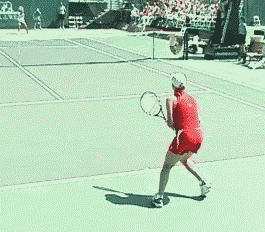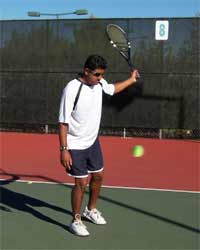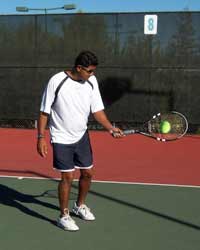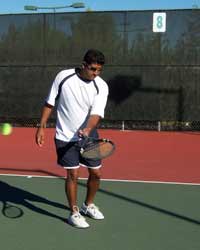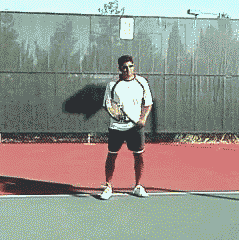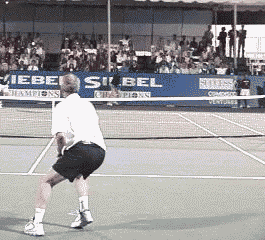|
TennisOne Lessons
You're trading groundstrokes two feet behind the baseline, and suddenly there it is. A short ball comes towards you, floating ever so slowly, it's hang time seems eternal. You sprint towards the ball confidently, only to realize it's tantalizingly just beyond your grasp. This, my friends, is called The Knee Buckling Drop Shot. The drop shot is one of those strokes that, if you pull it off, can really change the momentum of a game or a match. On the pro level, nothing elicits more oohs and ahs from the crowd then the well disguised drop shot. At the club level, it can be demoralizing. The drop shot clearly demonstrates how quick your opponent is, how comfortable he is at the net, and late in the match, how physically tired he might be. A drop shot is best hit when your opponent is behind the baseline and you are inside it. Hit with backspin, barely clearing the net, it is used to draw your opponent to the net to out right win the point or to get him out of position so you can easily win the point with a passing shot or a lob. Does Your Opponent Play the Net?Early on, find out whether or not your opponent is comfortable playing the net. Check out his or her grip, if it's an extreme western, there's a pretty good chance your opponent isn't a net rusher because it's a long way from there to a preferable (continental) volley grip. Plan your strategy in the warm up. See how he/she volleys or if he/she even comes up to the net to during the warm up at all.
Perhaps your opponent moves side to side very well camped out 4-6 feet behind the baseline and runs everything down. I see this scenario often, especially among women and junior girls. So brake the baseline rhythm by testing your opponent early in the match. Throw in a shallow ball (a ball that should bring your opponent scampering to the net) does he continue on to the net or does he hit and immediately retreat back to the baseline? If it's the latter, a good drop shot every now and then is a smart tactic. Throwing in the Drop ShotSo, when do you hit a drop shot? From on or inside the baseline, pick a ball you can easily control and manage - a ball without a lot of pace. Attempting a drop shot from behind the baseline is at best, extremely risky, at worst, suicidal. Like dropping a bunt down the third base line, it's best if the defender is playing deep and not expecting it. In this case, well behind the baseline. Remember, a drop shot is a touch shot. Being aware of your court position and that of your opponent is critical for effective execution. Key ElementsStart with the Continental Grip. Using the continental grip, it's easiest to impart tight backspin on the ball. Backspin prevents the ball from sitting up and jumping forward towards your opponent. So backspin is critical when playing an opponent who moves very well. Although you can hit backspin with an eastern forehand grip, the ball tends to float a little bit too much and the backspin is not as tight. Soften your hands for an effective stroke. If you have a death grip on the racquet to the point where your knuckles are turning white your wrist will remain rigid. Locking up the wrist will make it difficult to impart any backspin on the ball. And more often than not, a drop shot without backspin is not going to get it done.
To impart backspin on the ball, set up as you would for a slice backhand or forehand with the racquet head above the contact point. Be careful not to chop down towards the ground at contact. It's best to finish with your racquet head almost at the same height as the contact point. Remember, this is a touch shot and in order to execute the shot properly you must have a short take back and very short follow through after contact. Your contact point should be close to your body. The more you reach the less control of the ball you have. When learning to hit the drop shot, try setting your feet before executing. Controlling your racquet head speed on the move is more difficult, especially when executing a delicate stroke like this. Once you have mastered the feel then work on hitting this stroke on the move. Disguise is a key element to any successful drop shot. If your opponent knows it's coming, he'll most likely get to it in time no matter how well placed it is. So make sure you hide the stroke by setting up as you would for a slice and use the stroke judiciously.
Strategy/PatternIn general, aim your drop shots crosscourt rather than down the line. Obviously your decision has to be made based on your court positioning as well as your opponent's. The crosscourt shot is safer though because you have more room, hence more margin for error. And, if you poorly execute the stroke, at least the ball will most likely be angling away rather than moving towards your opponent as when you hit it down the line. The Drop Shot Attack PatternThe drop shot attack pattern is one of my favorites. The next time your opponent feeds you a short ball, instead of choosing between hitting a drop shot or attacking with an approach shot, why not do both. Instead of your traditional deep approach shot, hit a short shallow drop shot and rush the net. When you rush the net, you cut of any angle your opponent may have and by forcing him to hit up, you may find yourself in position to bunt the easy put-away into the open court. Be careful here. Often I see players, in their hurry to get to the net, fail to set up properly. The tendency here is to run through the ball. So remember, hit first then rush the net. I guarantee you'll get there in time. The Drop Shot and Return of ServeA drop shot return can be very effective, especially in doubles. If your opponent's like to play a one up one back formation, extremely common at the club level, angle a crosscourt drop shot towards the alley on the return. You will either win the point out right or you will create an opening to hit a favorable shot for your partner or yourself. Remember, hit the drop shot when you can control the ball and when you are well inside the baseline. This combination is most likely to occur on the second serve. So be ready, then pick out a ball you can handle and give it a go. The Drop Shot Lob PatternThe drop shot lob pattern can frustrate and tire your opponent especially if he is a retriever. The idea is to draw your opponent towards the net with a deftly placed drop shot then lob over his head when he closes too close and watch him scramble after the ball or just stare at it in frustration. A few exchanges like this can really change the momentum of a match and sap the will out of even the best mover. Four Steps to an Effective Drop Shot
So once again, disguise, soft hands, a ball you can manage from inside the baseline and a continental grip for backspin, the key ingredients for a knee buckling drop shot. Your comments are welcome. Let us know what you think about Monty Basnyat's article by emailing us here at TennisONE.
|
To contact us, please email to: webmaster@tennisone.com TennisONE is a registered trademark of TennisONE and SportsWeb ONE; Copyright 1995. All rights reserved. |
||||||||||

